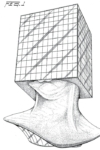 Werner Herzog’s narration verges on self-parody (probably because it’s so ripe for it) during the lowest points of Cave of Forgotten Dreams, a mostly unfocused but sometimes beautiful exploration of the world’s oldest cave paintings. Once a year, a group of French academics are allowed to explore and document the cave paintings, which eerily reveal a time when hippopotamus roamed Europe and when man had just begun to separate himself from the elements. Herzog confronts the eccentric figures who gather annually at the cave, asking “What do you think the cave-people dreamed of?” The french archaeologists are baffled by such obtuse questions. We’re rewarded with another breathtaking panning shot of the caves. The cavepeople dreamed about horses and bears, probably.
Werner Herzog’s narration verges on self-parody (probably because it’s so ripe for it) during the lowest points of Cave of Forgotten Dreams, a mostly unfocused but sometimes beautiful exploration of the world’s oldest cave paintings. Once a year, a group of French academics are allowed to explore and document the cave paintings, which eerily reveal a time when hippopotamus roamed Europe and when man had just begun to separate himself from the elements. Herzog confronts the eccentric figures who gather annually at the cave, asking “What do you think the cave-people dreamed of?” The french archaeologists are baffled by such obtuse questions. We’re rewarded with another breathtaking panning shot of the caves. The cavepeople dreamed about horses and bears, probably.
The choice to shoot in 3-D only becomes clear during the last 20 minutes of the film, which is a showcase of the paintings set to mournful strings. The paintings were made along uneven walls, walls that jut out and recede just as suddenly. To capture the motion of the paintings and the unique traits of the canvas, the stereo-optic effect works extremely well.
What Herzog wants to get after however, is the mind of these people from long ago. He wants to know who they worshipped, what their fears were. But it’s too far in the past- ultimately he settles for a reflection of ourselves. The postscript to the film is a tropical dome where nuclear runoff irradiates captive animals causing mutations like albinism. The dome is only a few miles from the caves. Whereas the paintings are a reflection of man’s ability to represent the natural world in a cartoonish, naive, and endearing way, the albino crocodiles reflect our ability to change nature into the grotesque.
Rarely is such a unified vision of the whole natural world available as exists in the caves, and Herzog has done right by dutifully documenting it, while adding very little mass to the film with his fuzzy meditations.
This post may contain affiliate links.






